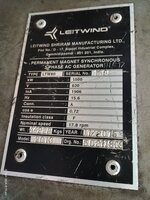You may have misunderstood the term Permanent Magnet Generator.
Before the advent of PMGs diesel generators supplied power to the Automatic Voltage Regulator from the main generator output.
Some AVRs had sense terminals to sample the output voltage and power terminals where power was supplied to the AVR from the generator output, either directly or by a small transformer.
Some AVRs combined sense and power into one pair of terminals.
This scheme was prone to voltage collapse where a fault or extreme overload would draw the output voltage down and as a result the AVR would not have enough voltage supplied to bring the output voltage back up.
The permanent magnet generator is a small generator that is typically mounted on the generator shaft, outboard of the back end bearing of the generator.
The job of the PMG is to supply power to the AVR.
The last few that I worked on generated about 220 Volts, three phase and were paired with an AVR that expected a 220 Volt, three phase, power supply.
PMG equipped sets avoid voltage collapse and tolerate block loading better than self excited machines.
When ordering a 333 kW generator a PMG may be standard equipment or it may be an extra cost option.
In the event of failure of a PMG or of a PMG AVR, a machine may, in some cases, be operated temporarily with a self excited AVR until spares arrive.
When using a self excited AVR on a system designed for a PMG, fault protection may be compromised and voltage dips due to block loading may be greater.
By the way, did you mean 333 KVA? Generator capacity is limited by KVA, not kW.
kW is a description of the prime mover's minimum capability.
If you need 333 kW, the generator nameplate will probably show:
416 KVA, 0.8 PF.
A 333 KVA machine will supply 333 kW only to a load of unity power factor.
A 333 kW load at unity PF is extremely rare in the real world.
I did that in the past for Asynchronous Generator and Synchronous Generator (field excitable), but never for PSMG
Did you use a CT supplied circuit to provide excitation boost to avoid voltage collapse?
This is not needed with a PMG and PMG AVR.
Your lineup will be:
Speed controlled by a governor that is controlling the prime mover.
Voltage control by set point on the AVR.
Load control by a 5% droop setting on the governor.
PF control by voltage adjustment.
PMG equipped generator and PMG ready AVR.
In a distributed generation scheme, you may generate 333 kW with a 333 KVA rated generator by running at unity power factor.
However you must consult your tariffs to see if running at unity PF will be acceptable.
Some tariffs will specify some amount of KVARs be supplied.
Your no-load, off-line from the grid, speed/frequency will be controlled by the governor.
Your on-line speed/frequency will be controlled by the grid.
Your loading will be controlled by the governor. (Governor set to grid speed/frequency will be zero load. Governor set to grid frequency plus droop percentage, 105% of grid with 5% droop, will be 100% load on the set.)
Off-line your AVR will control the voltage.
On-line the AVR will control the PF and the grid will control the voltage.
Sequence of operation for self excited or PMG excited.
1. Set the governor to the grid speed/frequency.
2. Start the set and bring it up to grid speed frequency.
3. Adjust the voltage to match the grid voltage.
4. Use either a sync check circuit or a synchroscope to connect the generator online.
5. Advance the governor setting to pick up the load. With 5% droop, each 1% additional over-speed will pick up 20% of the load.
Governor setting;---Loading:
100% speed = 0% load.
101% speed = 120% load.
102% speed = 140% load.
103% speed = 160% load.
104% speed = 180% load.
105% speed = 100% load.
Note that the actual speed will be controlled by the grid.
In control engineering terms, we are using the Proportional function of a PID controller. The offset, or difference between the set-point and process variable is what controls the loading.
Adjust the voltage setting too control the PF.
Note: The speed setting and the voltage setting interact.
The normal procedure is to advance the speed setting a little and then adjust the voltage setting a little.
Rinse and repeat until you are st the setting you desire.



